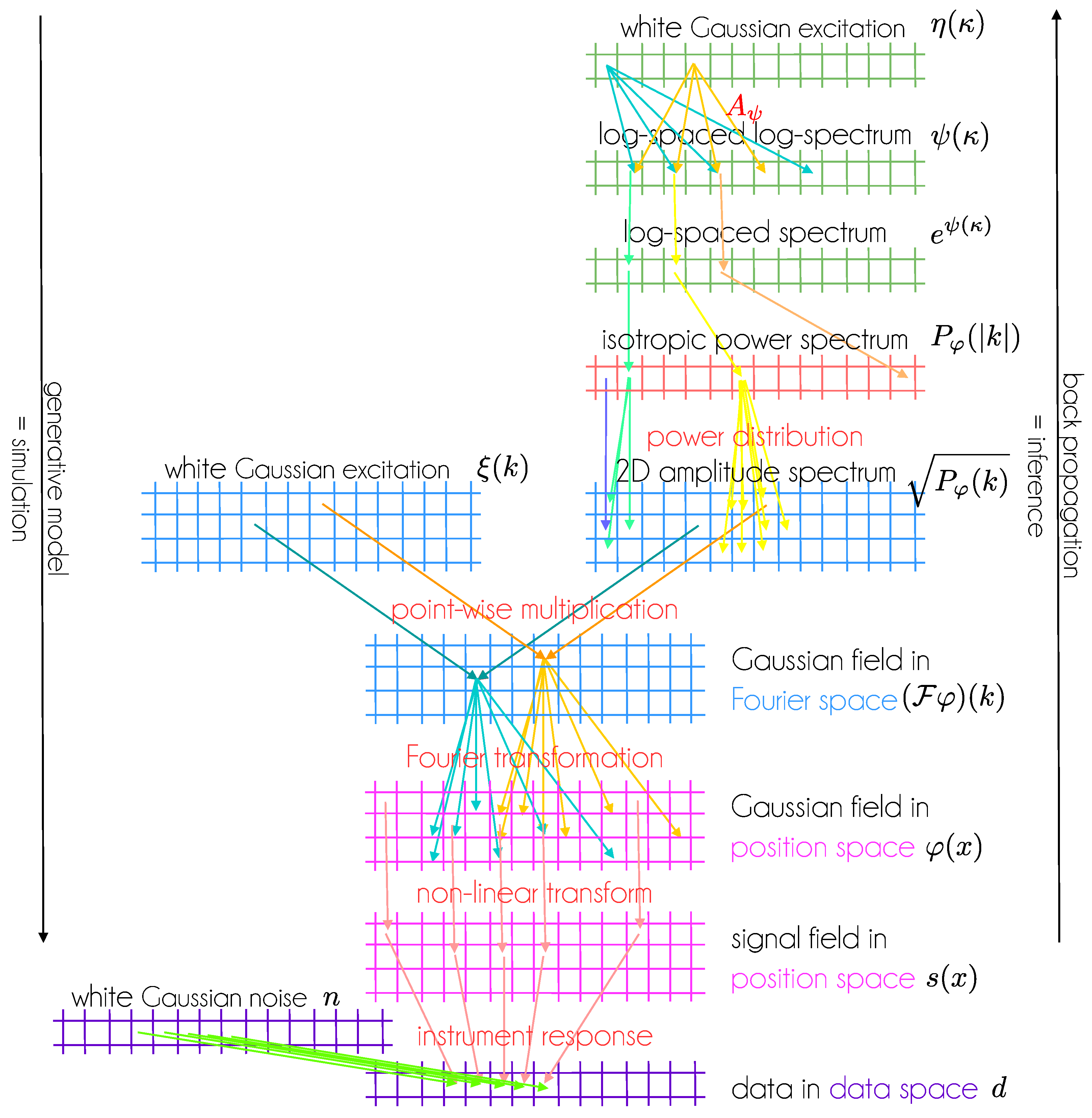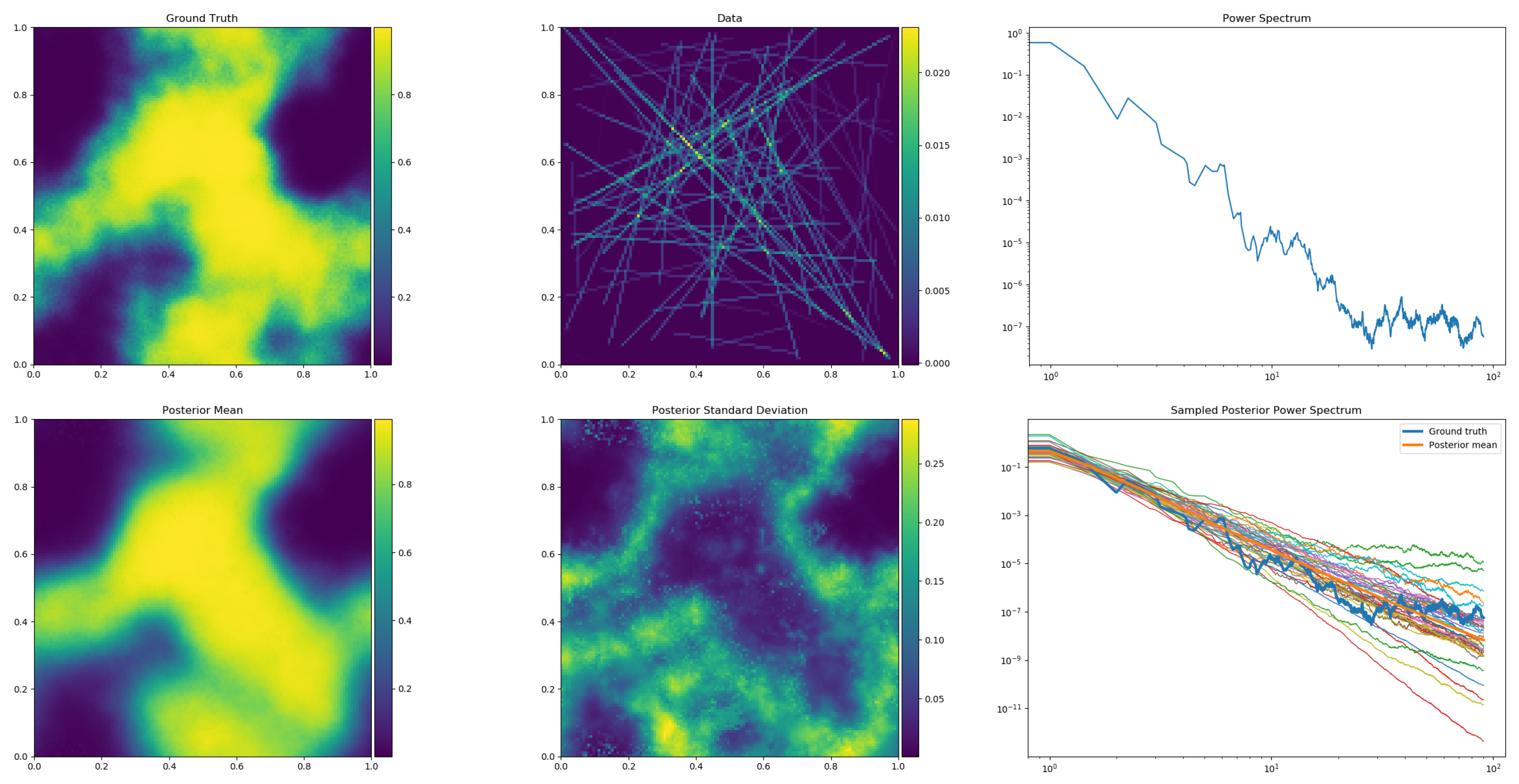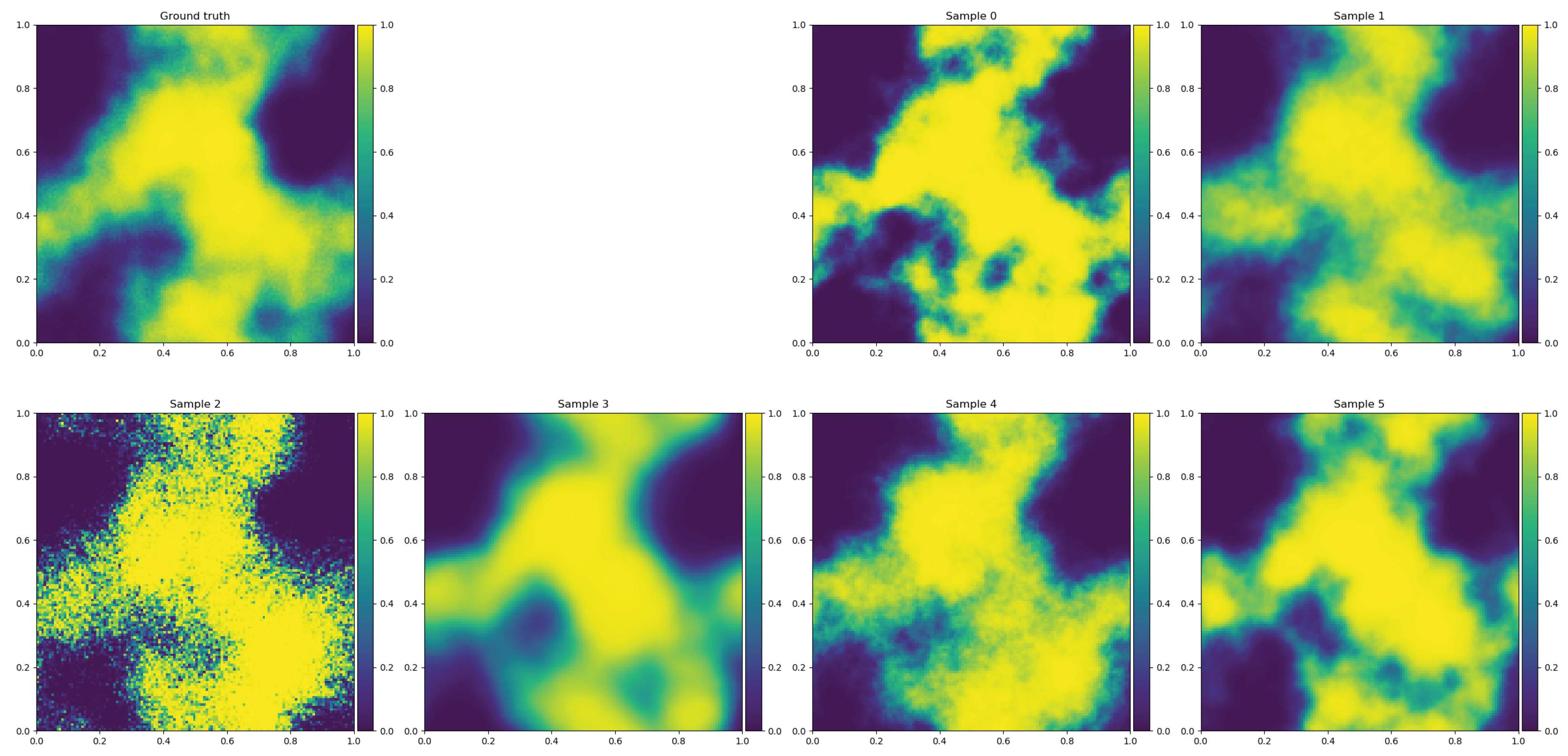Information Field Theory and Artificial Intelligence
Abstract
:1. Motivation
2. Information Field Theory
2.1. Basics
2.2. Prior Standardization
2.3. Power Spectra
2.4. Amplitude Model
2.5. Dynamical Systems
2.6. Generative Model
3. Artificial Intelligence
3.1. Neural Networks
3.2. Comparison with IFT Models
4. Variational Inference
4.1. Basic Idea
- mean field theory, in which is assumed to be diagonal, as used by ADVI
- the usage of the Fisher information to approximate as a function of and thereby effectively removing the DoF of from the optimization problem as used by MGVI
- a coordinate transformation of the latent space that approximately standardizes the posterior and therefore sets the covariance to the identity matrix in the new coordinates, as performed by geoVI.
4.2. ADVI and Mean Field Approximation
4.3. MGVI and Fisher Information Metric
4.4. Exact Uncertainty Covariance
4.5. Geometric Variational Inference
5. Conclusions and Outlook
Funding
Data Availability Statement
Acknowledgments
Conflicts of Interest
References
- Enßlin, T.A.; Frommert, M.; Kitaura, F.S. Information field theory for cosmological perturbation reconstruction and nonlinear signal analysis. Phys. Rev. D 2009, 80, 105005. [Google Scholar] [CrossRef] [Green Version]
- Enßlin, T.A. Information Theory for Fields. Ann. Phys. 2019, 531, 1800127. [Google Scholar] [CrossRef] [Green Version]
- Bialek, W.; Zee, A. Statistical mechanics and invariant perception. Phys. Rev. Lett. 1987, 58, 741–744. [Google Scholar] [CrossRef] [PubMed]
- Lemm, J.C. Bayesian Field Theory; JHU Press: Baltimore, MD, USA, 2003. [Google Scholar]
- Oppermann, N.; Junklewitz, H.; Robbers, G.; Bell, M.R.; Enßlin, T.A.; Bonafede, A.; Braun, R.; Brown, J.C.; Clarke, T.E.; Feain, I.J.; et al. An improved map of the Galactic Faraday sky. Astron. Astrophys. 2012, 542, A93. [Google Scholar] [CrossRef] [Green Version]
- Oppermann, N.; Junklewitz, H.; Greiner, M.; Enßlin, T.A.; Akahori, T.; Carretti, E.; Gaensler, B.M.; Goobar, A.; Harvey-Smith, L.; Johnston-Hollitt, M.; et al. Estimating extragalactic Faraday rotation. Astron. Astrophys. 2015, 575, A118. [Google Scholar] [CrossRef] [Green Version]
- Junklewitz, H.; Bell, M.R.; Enßlin, T. A new approach to multifrequency synthesis in radio interferometry. Astron. Astrophys. 2015, 581, A59. [Google Scholar] [CrossRef]
- Imgrund, M.; Champion, D.J.; Kramer, M.; Lesch, H. A Bayesian method for pulsar template generation. Mon. Not. R. Astronmical Soc. 2015, 449, 4162–4183. [Google Scholar] [CrossRef]
- Selig, M.; Vacca, V.; Oppermann, N.; Enßlin, T.A. The denoised, deconvolved, and decomposed Fermi γ-ray sky. An application of the D3PO algorithm. Astron. Astrophys. 2015, 581, A126. [Google Scholar] [CrossRef] [Green Version]
- Dorn, S.; Greiner, M.; Enßlin, T.A. All-sky reconstruction of the primordial scalar potential from WMAP temperature data. J. Cosmol. Astropart. Phys. 2015, 2015, 041. [Google Scholar] [CrossRef] [Green Version]
- Knollmüller, J.; Frank, P.; Enßlin, T.A. Separating diffuse from point-like sources—A Bayesian approach. arXiv 2018, arXiv:1804.05591. [Google Scholar]
- Arras, P.; Frank, P.; Leike, R.; Westermann, R.; Enßlin, T.A. Unified radio interferometric calibration and imaging with joint uncertainty quantification. Astron. Astrophys. 2019, 627, A134. [Google Scholar] [CrossRef]
- Hutschenreuter, S.; Enßlin, T.A. The Galactic Faraday depth sky revisited. Astron. Astrophys. 2020, 633, A150. [Google Scholar] [CrossRef]
- Leike, R.H.; Glatzle, M.; Enßlin, T.A. Resolving nearby dust clouds. Astron. Astrophys. 2020, 639, A138. [Google Scholar] [CrossRef]
- Arras, P.; Frank, P.; Haim, P.; Knollmüller, J.; Leike, R.; Reinecke, M.; Enßlin, T. M87* in space, time, and frequency. arXiv 2020, arXiv:2002.05218. [Google Scholar]
- Arras, P.; Bester, H.L.; Perley, R.A.; Leike, R.; Smirnov, O.; Westermann, R.; Enßlin, T.A. Comparison of classical and Bayesian imaging in radio interferometry. arXiv 2020, arXiv:2008.11435. [Google Scholar] [CrossRef]
- Hutschenreuter, S.; Anderson, C.S.; Betti, S.; Bower, G.C.; Brown, J.A.; Brüggen, M.; Carretti, E.; Clarke, T.; Clegg, A.; Costa, A.; et al. The Galactic Faraday rotation sky 2020. arXiv 2021, arXiv:2102.01709. [Google Scholar] [CrossRef]
- Mertsch, P.; Vittino, A. Bayesian inference of three-dimensional gas maps. I. Galactic CO. Astron. Astrophys. 2021, 655, A64. [Google Scholar] [CrossRef]
- Davis, J.H.; Enßlin, T.; Bœhm, C. New method for analyzing dark matter direct detection data. Phys. Rev. D 2014, 89, 043505. [Google Scholar] [CrossRef] [Green Version]
- Huang, X.; Enßlin, T.; Selig, M. Galactic dark matter search via phenomenological astrophysics modeling. J. Cosmol. Astropart. Phys. 2016, 2016, 030. [Google Scholar] [CrossRef] [Green Version]
- Welling, C.; Frank, P.; Enßlin, T.; Nelles, A. Reconstructing non-repeating radio pulses with Information Field Theory. J. Cosmol. Astropart. Phys. 2021, 2021, 071. [Google Scholar] [CrossRef]
- Selig, M.; Oppermann, N.; Enßlin, T.A. Improving stochastic estimates with inference methods: Calculating matrix diagonals. Phys. Rev. E 2012, 85, 021134. [Google Scholar] [CrossRef] [PubMed] [Green Version]
- Enßlin, T.A. Information field dynamics for simulation scheme construction. Phys. Rev. E 2013, 87, 013308. [Google Scholar] [CrossRef] [PubMed] [Green Version]
- Leike, R.H.; Enßlin, T.A. Towards information-optimal simulation of partial differential equations. Phys. Rev. E 2018, 97, 033314. [Google Scholar] [CrossRef] [PubMed] [Green Version]
- Kurthen, M.; Enßlin, T. A Bayesian Model for Bivariate Causal Inference. Entropy 2019, 22, 46. [Google Scholar] [CrossRef] [PubMed] [Green Version]
- Frank, P.; Leike, R.; Enßlin, T.A. Field Dynamics Inference for Local and Causal Interactions. Ann. Phys. 2021, 533, 2000486. [Google Scholar] [CrossRef]
- Enßlin, T.A.; Knollmüller, J. Correlated signal inference by free energy exploration. arXiv 2016, arXiv:1612.08406. [Google Scholar]
- Leike, R.; Enßlin, T. Optimal Belief Approximation. Entropy 2017, 19, 402. [Google Scholar] [CrossRef] [Green Version]
- Knollmüller, J.; Enßlin, T.A. Encoding prior knowledge in the structure of the likelihood. arXiv 2018, arXiv:1812.04403. [Google Scholar]
- Knollmüller, J.; Enßlin, T.A. Metric Gaussian Variational Inference. arXiv 2019, arXiv:1901.11033. [Google Scholar]
- Knollmüller, J.; Enßlin, T.A. Bayesian Reasoning with Trained Neural Networks. Entropy 2021, 23, 693. [Google Scholar] [CrossRef]
- Frank, P.; Leike, R.; Enßlin, T.A. Geometric Variational Inference. Entropy 2021, 23, 853. [Google Scholar] [CrossRef] [PubMed]
- Edward, C. Rasmussen and Christopher KI Williams. Gaussian Processes for Machine Learning; MIT Press: Cambridge, MA, USA, 2006; Volume 211, p. 212. [Google Scholar]
- Lassas, M.; Siltanen, S. Can one use total variation prior for edge-preserving Bayesian inversion? Inverse Probl. 2004, 20, 1537. [Google Scholar] [CrossRef]
- Saksman, M.L.; Siltanen, S. Discretization-invariant Bayesian inversion and Besov space priors. Inverse Probl. Imaging 2009, 3, 87. [Google Scholar]
- Enßlin, T.A.; Frommert, M. Reconstruction of signals with unknown spectra in information field theory with parameter uncertainty. Phys. Rev. D 2011, 83, 105014. [Google Scholar] [CrossRef] [Green Version]
- Enßlin, T.A.; Weig, C. Inference with minimal Gibbs free energy in information field theory. Phys. Rev. E 2010, 82, 051112. [Google Scholar] [CrossRef] [PubMed] [Green Version]
- Westerkamp, M.; Ovchinnikov, I.; Frank, P.; Enßlin, T. Dynamical Field Inference and Supersymmetry. Entropy 2021, 23, 1652. [Google Scholar] [CrossRef]
- Pumpe, D.; Reinecke, M.; Enßlin, T.A. Denoising, deconvolving, and decomposing multi-domain photon observations. The D4PO algorithm. Astron. Astrophys. 2018, 619, A119. [Google Scholar] [CrossRef] [Green Version]
- Nunez, P.L. The brain wave equation: A model for the EEG. Math. Biosci. 1974, 21, 279–297. [Google Scholar] [CrossRef]
- Amari, S.I. Homogeneous nets of neuron-like elements. Biol. Cybern. 1975, 17, 211–220. [Google Scholar] [CrossRef]
- Amari, S.i. Dynamics of pattern formation in lateral-inhibition type neural fields. Biol. Cybern. 1977, 27, 77–87. [Google Scholar] [CrossRef]
- Coombes, S.; Potthast, R. Tutorial on neural field theory. In Neural Fields; Springer: Berlin/Heidelberg, Germany, 2014; pp. 1–43. [Google Scholar]
- Frank, P.; Steininger, T.; Enßlin, T.A. Field dynamics inference via spectral density estimation. Phys. Rev. E 2017, 96, 052104. [Google Scholar] [CrossRef] [PubMed] [Green Version]
- Kingma, D.P.; Welling, M. Auto-Encoding Variational Bayes. arXiv 2013, arXiv:1312.6114. [Google Scholar]
- Selig, M.; Bell, M.R.; Junklewitz, H.; Oppermann, N.; Reinecke, M.; Greiner, M.; Pachajoa, C.; Enßlin, T.A. NIFTY—Numerical Information Field Theory. A versatile PYTHON library for signal inference. Astron. Astrophys. 2013, 554, A26. [Google Scholar] [CrossRef]
- Steininger, T.; Dixit, J.; Frank, P.; Greiner, M.; Hutschenreuter, S.; Knollmüller, J.; Leike, R.; Porqueres, N.; Pumpe, D.; Reinecke, M.; et al. NIFTy 3—Numerical Information Field Theory: A Python Framework for Multicomponent Signal Inference on HPC Clusters. Ann. Phys. 2019, 531, 1800290. [Google Scholar] [CrossRef] [Green Version]
- Arras, P.; Baltac, M.; Ensslin, T.A.; Frank, P.; Hutschenreuter, S.; Knollmueller, J.; Leike, R.; Newrzella, M.N.; Platz, L.; Reinecke, M.; et al. NIFTy5: Numerical Information Field Theory v5. 2019. Available online: https://ascl.net/1903.008 (accessed on 6 March 2022).
- Kramer, M.A. Nonlinear principal component analysis using autoassociative neural networks. AIChE J. 1991, 37, 233–243. [Google Scholar] [CrossRef]
- Goodfellow, I.; Pouget-Abadie, J.; Mirza, M.; Xu, B.; Warde-Farley, D.; Ozair, S.; Courville, A.; Bengio, Y. Generative adversarial nets. Adv. Neural Inf. Process. Syst. 2014, 27. [Google Scholar]
- Ulyanov, D.; Vedaldi, A.; Lempitsky, V. Deep Image Prior. Int. J. Comput. Vis. 2020, 128, 1867–1888. [Google Scholar] [CrossRef]
- Leike, R.H.; Enßlin, T.A. Charting nearby dust clouds using Gaia data only. Astron. Astrophys. 2019, 631, A32. [Google Scholar] [CrossRef] [Green Version]
- Leike, R.H.; Enßlin, T.A. Operator calculus for information field theory. Phys. Rev. E 2016, 94, 053306. [Google Scholar] [CrossRef] [Green Version]
- Kucukelbir, A.; Tran, D.; Ranganath, R.; Gelman, A.; Blei, D.M. Automatic differentiation variational inference. J. Mach. Learn. Res. 2017, 18, 430–474. [Google Scholar]
- Rezende, D.; Mohamed, S. Variational Inference with Normalizing Flows. In Proceedings of the 32nd International Conference on Machine Learning, Lille, France, 7–9 July 2015; Volume 37, pp. 1530–1538. [Google Scholar]



Publisher’s Note: MDPI stays neutral with regard to jurisdictional claims in published maps and institutional affiliations. |
© 2022 by the author. Licensee MDPI, Basel, Switzerland. This article is an open access article distributed under the terms and conditions of the Creative Commons Attribution (CC BY) license (https://creativecommons.org/licenses/by/4.0/).
Share and Cite
Enßlin, T. Information Field Theory and Artificial Intelligence. Entropy 2022, 24, 374. https://doi.org/10.3390/e24030374
Enßlin T. Information Field Theory and Artificial Intelligence. Entropy. 2022; 24(3):374. https://doi.org/10.3390/e24030374
Chicago/Turabian StyleEnßlin, Torsten. 2022. "Information Field Theory and Artificial Intelligence" Entropy 24, no. 3: 374. https://doi.org/10.3390/e24030374
APA StyleEnßlin, T. (2022). Information Field Theory and Artificial Intelligence. Entropy, 24(3), 374. https://doi.org/10.3390/e24030374





